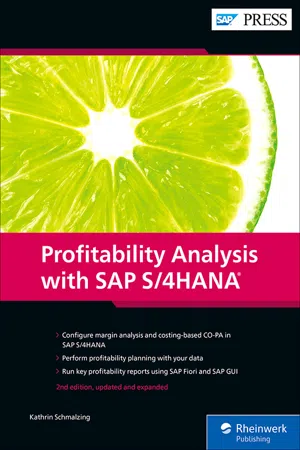
This is a test
- 480 pages
- English
- ePUB (mobile friendly)
- Available on iOS & Android
eBook - ePub
Profitability Analysis with SAP S/4HANA
Book details
Book preview
Table of contents
Citations
Frequently asked questions
At the moment all of our mobile-responsive ePub books are available to download via the app. Most of our PDFs are also available to download and we're working on making the final remaining ones downloadable now. Learn more here.
Both plans give you full access to the library and all of Perlego’s features. The only differences are the price and subscription period: With the annual plan you’ll save around 30% compared to 12 months on the monthly plan.
We are an online textbook subscription service, where you can get access to an entire online library for less than the price of a single book per month. With over 1 million books across 1000+ topics, we’ve got you covered! Learn more here.
Look out for the read-aloud symbol on your next book to see if you can listen to it. The read-aloud tool reads text aloud for you, highlighting the text as it is being read. You can pause it, speed it up and slow it down. Learn more here.
Yes, you can access Profitability Analysis with SAP S/4HANA by Kathrin Schmalzing in PDF and/or ePUB format, as well as other popular books in Computer Science & Computer Science General. We have over one million books available in our catalogue for you to explore.
Information
1 Introduction to Profitability Analysis
Profitability analysis in SAP S/4HANA has been revolutionized. In this chapter, you’ll get an overview of the latest changes and all the information you need to understand the different types of profitability analysis.
Profitability analysis is a subcomponent of controlling with SAP S/4HANA. Profitability analysis in SAP S/4HANA is used to display the internal view of accounting that supports managers in their decision-making. The data in profitability analysis is enriched with numerous characteristics derived from the value flow of predecessor documents and therefore can be displayed and analyzed from various angles. In SAP ERP, there are two types of Profitability Analysis (CO-PA): account-based and costing-based. In SAP S/4HANA, on the other hand, you’ll find costing-based profitability analysis and margin analysis. This chapter describes the differences between costing-based profitability analysis and margin analysis both from functional and technical viewpoints. You’ll learn which type of profitability analysis is your go-to for the future.
1.1 Purpose of Profitability Analysis
Processing and analyzing data is one of the most important tasks in a company. Data is required to know how a company is doing and to make both short-term and long-term decisions. There are two recipients for data who have different interests, which is why there are two data different views as well:
- External view
Defined by the commercial law and accounting principles, the external view gives an overview of the company’s assets (e.g., cash, inventory, accounts receivables), liabilities (e.g., accounts payable, loans payable, accruals), and the owner’s equity.Recipients include executive management, owners, banks, and investors. - Internal view
Defined by management requirements for the evaluation of business areas and profit centers, the internal view assigns costs to the responsible cost objects and identifies the most profitable products and services, as well as areas where overspending occurs.Recipients include executive management, business area owners, and product owners.
Traditional data models in enterprise resource (ERP) systems generally focus on the collection of data, aggregations, and reporting for the external view of profitability.
Today, the need for information in real time as well as flexibility in profitability continues to increase. Enterprises have different requirements now as they face a more competitive and innovative market. Profitability is measured at the lowest possible level to improve decision-making processes, to react quickly to changes in the market, and to even be a step ahead. Those new requirements are reasons for the recent developments and changes in the profitability analysis. Thanks to real-time analytics, this instant market information gives you better and faster insights and allows for better de...
Table of contents
- Dear Reader
- Notes on Usage
- Table of Contents
- Introduction
- 1 Introduction to Profitability Analysis
- 2 Configuring the Operating Concern and Basic Settings for Profitability Analysis
- 3 Configuring Characteristics
- 4 Configuring Value Fields and Quantity Fields for Costing-Based Profitability Analysis
- 5 Configuring Value Flows for Margin Analysis
- 6 Configuring Value Flow for Costing-Based Profitability Analysis
- 7 Planning
- 8 Reporting
- A Changes to the Data Model
- B Additional Sources of Information
- C The Author
- Index
- Service Pages
- Legal Notes